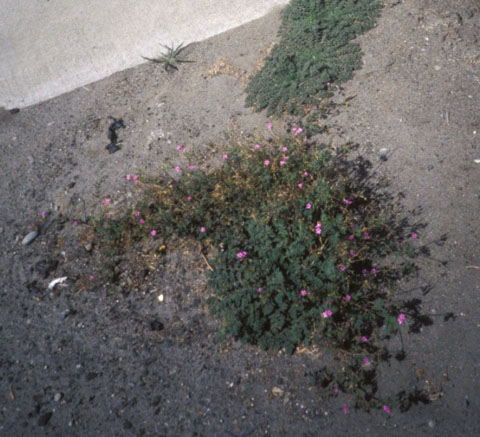
|
| Filaree; Erodium cicutarium (L.) L'Hér. |
Geranium Family; GERANIACEÆ
|
| Filaree, a pretty, pink-flowered plant, is as much a wildflower as a weed. It tends to be common only where sandy, gravelly, dry
soils predominate; where topsoil is scanty or absent, the wind blows unimpeded, and the sun beats down powerfully. In other words,
blasted waste areas. Many shoreline areas, bluffs and ridges fit this ideal Filaree habitat. In such places the plant is tight, low and
sprawling. Filaree infrequently grows in rich, loosened garden soils, and is even less weedy-looking then, being luxurious in growth, larger
in size, and neither dusty nor downtrodden. |
| The plant is from the Old World, and has become a major non-native resident in much of the West; in California,
particularly, Filaree is common. It has great forage value, which caused it to be planted widely. Besides being nutritious and adapted to trying
soil conditions, Filaree is adaptable in its life-cycle: usually an annual, it can be a biennial or short-lived perennial. |
| Beginning in late March and lasting at least well into July it opens intense pink flowers, which although small, are
endearing. These are succeeded by beak-like seedpods that forcibly spiral back upon maturity. Because of these conspicuously pointed
seedpods, the plant earned its name Stork's-bill; the scientific name
Erodium derives from the Greek
erodios, a heron. Other names are Redstem Filaree, Alfilaria (from Spanish
alfiler, a pin), Pinweed or Pin Clover. It is closely related to geraniums, such as Herb Robert
(Geranium Robertianum, Weed of the Month December 1986). |
Filaree is edible, bland, faintly cucumber-flavored. The entire plant has clear little hairs on it, which render it chewy,
astringent, and less agreeably textured than it would be were it bald. Nonetheless, add some tender young leaves to salads; they are bite sized
as is, so you need not cut or shred them, and they resemble the leaves of Salad Burnet in their ferny appearance. Filaree flowers, too,
are a dainty condiment. One study showed Filaree to be a major source of Vitamin A. To a limited extent Filaree has been used in
herbal medicine, as a hemostatic. Some of its perennial cousins are grown as ornamentals in flower borders.
|
Originally published as the Seattle Tilth newsletter Weed of the Month in April 1993, along with an illustration from a book.
Back |
|
|

